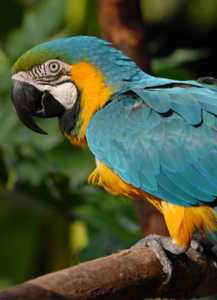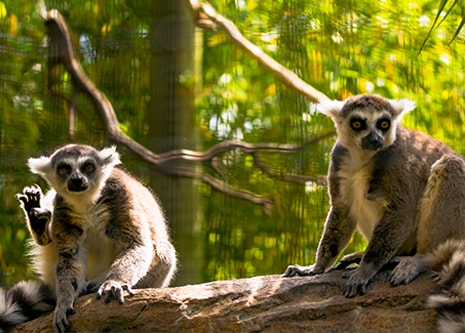
- VisitSupport Happy HollowDONATE TODAYExploreSupport Happy HollowDONATE TODAYLearnSupport Happy HollowDONATE TODAYSupport
-
Today's Hours: 10:00 am to 5:00 pm
Zoo in the HollowBlue and gold macaw

Scientific name: Ara ararauna
Family: Psittacidae
Order: Psittaciformes
Class: Aves
Range: Central and South America
Habitat: Subtropical and Tropical Forest Lifespan: 40-50 years on average; up to 75 years in captivityWhat do they look like?
Blue and gold macaws typically weigh around two pounds and are 30 to 34 inches long, more than half of which is the tail. Their faces are relatively bare, white in color with sparse black feathers, and a large black beak strong enough to break open nutshells. Their feet are zygodactyl (they have two toes facing forwards and two facing backwards). They have vibrant blue feathers on the top side of their wings and tail, with yellow on the undersides of each. They also have a patch of dark blue or black under the facial patch and a green forehead.How do they behave?
Macaws are particularly curious, intelligent, and social birds. They typically live in pairs or large family groups. These family groups can consist of between 10 to 30 birds. Macaws also use many different types of sounds to communicate with each other. They use these vocalizations for many different purposes such as identifying each other and signaling the approach of predators. They form strong bonds with their mate and flock; when these bonds are broken they exhibit signs of stress.What do they eat?
Macaws eat mostly fruits, seeds and nuts. They may also feed on nectar and flower buds. They have been observed gathering at clay licks, which provide high levels of sodium and have the potential to nullify the effects of toxins they may have ingested. Some foods are toxic to macaws, such as cherries and avocados. At Happy Hollow, they eat fruit, vegetables, greens, seeds, nuts, specialized parrot food and vitamin supplements.How are they born?
Macaws are typically monogamous, with the mating season lasting six to eight weeks in the spring. The female nests in a tree cavity and lays two to three eggs. She incubates the eggs for approximately 28 days. Chicks hatch with pink skin and little to no feathers. Chicks fledge from the nest about 90 days after hatching.What should you know about them?
There are about 18 species of macaws which vary in size and color. They generally live in the same geographical regions and share habitat. Many macaw species are now endangered in the wild due in large part to habitat loss and the pet trade.Conservation
The blue and gold macaw’s conservation status is currently listed as Least Concern by the International Union for Conservation of Nature . While blue and gold macaws aren’t an endangered species at this time, they are still at risk due to a combination of factors. They face habitat loss through deforestation, and capture from the wild for pet trade. One organization focusing on blue and gold macaw conservation is the Centre for the Rescue of Endangered Species of Trinidad and Tobago (CRESTT). CRESTT aims to reintroduce blue and gold macaws to their native habitat in Trinidad through a captive breeding program. You can help blue and gold macaws by leaving these beautiful birds in the wild, rather than keeping them as pets. Due to large spatial needs and social interaction, these birds are much better suited for life in the wild. If you are looking for a new pet, check out your local humane society, there you will find people who can help you make the proper pet choice.
Zoo on the Hill
Located across from the Keep-Around Carousel is the Zoo on the Hill. Learn about wildlife up close during daily meet-and-greets, leap like a lemur on the playground, brush and feed the goats,, or take a peek inside Doc’s Critter Care building and the Ranch House. Double-H Ranch features a combination of animal exhibits, including giant anteaters and red ruffed lemurs, as well chickens and domesticated animals that are docile enough to touch.
See Animals
Education Ambassadors
From camps and classes to scout badges and sleepovers, Happy Hollow education programs have something for everyone! The zoo education program offers a broad range of hands-on, engaging programs and public presentations featuring education ambassador animals. These encounters are designed to connect you to wildlife and the conservation of their habitats around the world.
See AnimalsVisit Us Today
Plan an unforgettable experience at San Jose’s family-friendly park and zoo.
Learn More